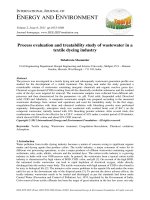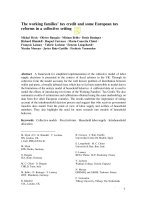International financial market and korean economy keynesian framework in a closed economy
Bạn đang xem bản rút gọn của tài liệu. Xem và tải ngay bản đầy đủ của tài liệu tại đây (5.44 MB, 29 trang )
International Finance and Korean Economy
Class 2
Keynesian Framework in a Closed Economy
Outline (Based on B&J)
1.
2.
3.
4.
5.
6.
Markets in the Kyenesian world
The Goods Market and the IS Relation
Financial Markets and the LM Relation
Combining IS and LM Curves
Policy Simulations within the IS-LM Framework
IS-LM and the Reality
2
Markets in the Keynesian World
Today we will learn about the Keynesian Framework
(so called the IS-LM framework).
Keynes considers that the following four types of markets in
the economy constitutes the aggregate economy.
A Goods Market (demand side)
A Money Market (demand side, financial market)
A Bond Market (demand side, financial market)
A Labor Market (supply side)
3
Where Are We Headed for
The Keynesian framework derives equilibrium conditions for
the markets for goods, money, and labor, and synthesize them.
The bond market equilibrium is guaranteed by Walras’
law.
Walras’ law tells that the sum of excess demands
across all the markets is equal to zero.
In other words, in an economy with n markets,
equilibrium in (n-1) markets guarantees that the other
market is already in equilibrium
4
1. The Goods Market and the IS Relation
Equilibrium in the goods market exists when production, Y,
is equal to the demand for goods, Z. This condition is called
the IS relation.
In
𝑌𝑌 = 𝑍𝑍
𝑍𝑍 = 𝐶𝐶 + 𝐼𝐼 + 𝐺𝐺
a simple model, the interest rate did not affect the
demand for goods. The equilibrium condition was given by:
Y = C(Y − T ) + I + G
1. The Goods Market and the IS Relation
Investment, Sales, and the Interest Rate
Investment depends primarily on two factors:
The level of aggregate income, equivalent with that of
sales, positively(+) related to investment.
The interest rate, an opportunity cost of investment, is
inversely(-) related to investment.
I = I (Y , i )
( + ,− )
1. The Goods Market and the IS Relation
Determining Output
Taking into account the investment relation, the equilibrium
condition in the goods market becomes:
Y = C(Y − T ) + I (Y , i ) + G
For a given value of the interest rate i, aggregate demand
is an increasing function of output, for two reasons:
An increase in output leads to an increase in income and
also to an increase in disposable income.
An increase in output also leads to an increase in
investment.
1. The Goods Market and the IS Relation
Determining Output
Note two characteristics of the Aggregate Demand Z:
So far it has been assumed that C and I are linear wrt Y.
But in general Z is a curve rather than a line.
Z is drawn flatter than a 45-degree line because it’s
assumed that an increase in output leads to a less than
one-for-one increase in demand (Remind the Paradox of
Saving).
1. The Goods Market and the IS Relation
Equilibrium
in the Goods Market
The demand for goods is an
increasing function of output.
Equilibrium requires that the
demand for goods be equal to
output.
Deriving the IS Curve
(a) An increase in the interest
rate decreases the demand
for goods at any level of
output, leading to a
decrease in the equilibrium
level of output.
(b) Equilibrium in the goods
market implies that an
increase in the interest rate
leads to a decrease in output.
The IS curve is therefore
downward sloping.
Shifts of the IS Curve
•We have drawn the IS curve, taking as given the values of
taxes, T, and government spending, G. Changes in either T
or G will shift the IS curve.
•To summarize:
Equilibrium in the goods market implies that an increase in the
interest rate leads to a decrease in output. This relation is
represented by the downward-sloping IS curve.
Changes in factors that decrease the demand for goods, given the
interest rate, shift the IS curve to the left. Changes in factors that
increase the demand for goods, given the interest rate, shift the IS
curve to the right.
1. The Goods Market and the IS Relation
Shifts of the IS Curve
An increase in taxes
shifts the IS curve to the
left.
2. Financial Markets and the LM Relation
The interest rate is determined by the equality of the supply
of and the demand for money:
M = $YL(i )
M = nominal money stock
$YL(i) = demand for money
$Y = nominal income
i = nominal interest rate
The equation M = $YL(i ) gives a relation between
money, nominal income, and the interest rate.
2. Financial Markets and the LM Relation
The interest rate is determined by the equality of the supply
of and the demand for money:
M = $YL(i )
M = nominal money stock
$YL(i) = demand for money
$Y = nominal income
i = nominal interest rate
The equation M = $YL(i ) gives a relation between
money, nominal income, and the interest rate.
2. Financial Markets and the LM Relation
Who supplies money?
Central Bank
Commercial Banks
Households
What is Money?
2. Financial Markets and the LM Relation
Scope of money?
Hi-Powered money
M1
M2
Deriving the LM Curve
2. Financial Markets and the LM Relation
Deriving the LM Curve
The plot in the right hand side of the previous slide
represents the equilibrium interest rate, i, on the
vertical axis against income on the horizontal axis.
This relation between output and the interest rate
is represented by the upward sloping curve called
the LM curve.
2. Financial Markets and the LM Relation
Shifts of the LM Curve
An increase in money
causes the LM curve
to shift down.
2. Financial Markets and the LM Relation
Shifts of the LM Curve
■ Equilibrium in financial markets implies that, for a
given real money supply, an increase in the level of
income, which increases the demand for money, leads to
an increase in the interest rate. This relation is
represented by the upward- sloping LM curve.
■ An increase in the money supply shifts the LM curve
down; a decrease in the money supply shifts the LM
curve up.
3. Combining IS and LM Curves
IS relation: Y = C(Y − T ) + I (Y , i ) + G
M
= YL(i )
LM relation:
P
4. Policy Simulations within the IS-LM Framework
Fiscal Policy, Activity, and the Interest Rate
Fiscal
contraction, or fiscal consolidation, refers
to fiscal policy that reduces the budget deficit.
An
increase in the deficit is called a fiscal
expansion.
Taxes
affect the IS curve, not the LM curve.
Fiscal Policy, Activity, and
the Interest Rate
Equilibrium in the goods market implies
that an increase in the interest rate
leads to a decrease in output. This is
represented by the IS curve.
Equilibrium in financial markets implies
that an increase in output leads to an
increase in the interest rate. This is
represented by the LM curve. Only at
point A, which is on both curves, are
both goods and financial markets in
equilibrium.
Monetary Policy, Activity, and the Interest Rate
Monetary contraction, or monetary tightening, refers to a
decrease in the money supply.
An increase in the money supply is called monetary
expansion.
Monetary policy does not affect the IS curve, only the LM
curve. For example, an increase in the money supply shifts
the LM curve down.
Monetary Policy, Activity, and the Interest Rate
The Effects of a
Monetary Expansion
A monetary expansion leads to
higher output and a lower
interest rate.









